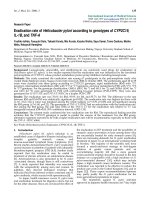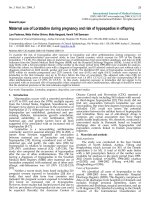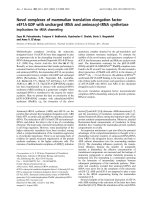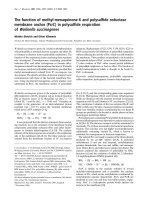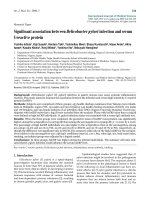Báo cáo y học: No associations of Helicobacter pylori infection and gastric atrophy with plasma total homocysteine in Japanes
Bạn đang xem bản rút gọn của tài liệu. Xem và tải ngay bản đầy đủ của tài liệu tại đây (438.45 KB, 7 trang )
Int. J. Med. Sci. 2007, 4
98
International Journal of Medical Sciences
ISSN 1449-1907 www.medsci.org 2007 4(2):98-104
© Ivyspring International Publisher. All rights reserved
Research Paper
No associations of Helicobacter pylori infection and gastric atrophy with
plasma total homocysteine in Japanese
Simon Itou
1,2
, Yasuyuki Goto
1
, Takaaki Kondo
3
, Kazuko Nishio
1
, Sayo Kawai
1
, Yoshiko Ishida
1
, Mariko
Naito
1
, and Nobuyuki Hamajima
1
1. Department of Preventive Medicine / Biostatistics and Medical Decision Making, Nagoya University Graduate School of
Medicine, 65 Tsurumai-cho, Showa-ku, Nagoya, 466-8550 Japan
2. Division of Thoracic Surgery, Department of Surgery, Nagoya University Graduate School of Medicine, 65 Tsurumai-cho,
Showa-ku, Nagoya, 466-8550 Japan
3. Department of Medical Technology, Nagoya University School of Health Sciences, 1-1-20 Daikominami, Higashi-ku, Na-
goya, 461-8673 Japan
Correspondence to: Simon Itou, Department of Preventive Medicine / Biostatistics and Medical Decision Making, Nagoya University
Graduate School of Medicine, 65 Tsurumai-cho, Showa-ku, Nagoya, 466-8550 Japan. E-mail: Phone:
+81-52- 744-2132 / Fax: +81-52-744-2971
Received: 2007.01.12; Accepted: 2007.03.13; Published: 2007.03.14
Recent studies have suggested that Helicobacter pylori (H. pylori) infection might be a risk factor for atherosclerosis.
Since the bacterium has not been isolated from atherosclerotic lesions, a direct role in atherogenesis is not plau-
sible. We examined associations of plasma total homocysteine (tHcy) and serum folate, independent risk factors
for atherosclerosis, with H. pylori infection and subsequent gastric atrophy among 174 patients (78 males and 96
females) aged 20 to 73 years, who visited an H. pylori eradication clinic of Nagoya University from July 2004 to
October 2005. Polymorphism genotyping was conducted for methylenetetrahydrofolate reductase (MTHFR) C677T
and thymidylate synthase (TS) 28-bp tandem repeats by PCR with confronting two-pair primers and PCR, respec-
tively. H. pylori infection and gastric atrophy were not significantly associated with hyperhomocysteinemia (tHcy
≥ 12 nmol/ml), when adjusted by sex, age, smoking, alcohol, and genotypes of MTHFR and TS. The adjusted
odds ratio of gastric atrophy for low folate level (≤ 4mg/ml) was 0.21 (95% confidence interval = 0.05-0.78). The
associations of tHcy with serum folate and MTHFR genotype were clearly observed in this dataset. The present
study demonstrated that folate and MTHFR genotype were the deterministic factors of plasma tHcy, but not H.
pylori infection and subsequent gastric atrophy, indicating that even if H. pylori infection influences the risk of
atherosclerosis, the influence may not be through the elevation of homocysteine.
Key words: Helicobacter pylori, homocysteine, methylenetetrahydrofolate reductase (MTHFR), thymidylate synthase (TS), gastric
atrophy
1. Introduction
Several epidemiologic studies have shown asso-
ciations between persistent gastric infection with
Helicobacter pylori and ischemic disorders [1-4]. The
ischemic diseases are also associated with plasma total
homocysteine (tHcy) level [5-7]. Hyperhomocysteine-
mia, usually defined as a plasma homocysteine level
greater than 15 nmol/ml, has been found in 5% to 10%
of general populations [8, 9], and as high as 30% of the
population aged 65 and older in the Framingham
Heart Study (tHcy > 14 nmol/ml) [10]. Increasing tHcy
concentrations accelerate cardiovascular diseases by
promoting vascular inflammation, endothelial dys-
function, and hypercoagulability [11].
An important metabolic pathway for homocys-
teine is the remethylation cycle; in this reaction ho-
mocysteine is converted into methionine by methion-
ine synthase. The folic acid–methionine pathway is
particularly relevant to the control of genome stability,
and involves a number of critical enzymes for which
several polymorphisms have been identified. The ac-
tivity of methylenetetrahydrofolate reductase
(MTHFR) can be reduced by polymorphisms of
MTHFR that alter its affinity for the substrate or co-
factor [12]. There were several studies on the associa-
tion between hyperhomocysteinemia and H. pylori
infection, but the results were inconsistent [1, 2, 13-16].
Thymidylate synthase (TS) gene encodes the en-
zyme that catalyzes the conversion of deoxyuridylate
to thymidylate. The enzyme expression is reportedly
affected by a 28bp tandem repeat polymorphism. The
3R3R homozygotes increased tHcy in a Chinese
population, possibly because TS and MTHFR compete
for limiting supplies of folate, which is required for the
remethylation of homocysteine [17]. However, another
study showed that the tHcy concentrations for 3R3R
homozygotes did not differ significantly from those for
2R2R homozygotes or 2R3R heterozygotes in healthy
young subjects [18].
Several pathways by which H. pylori infection
could lead to atherosclerosis have been hypothesized
Int. J. Med. Sci. 2007, 4
99
(Figure 1). Among them, the routes from H. pylori in-
fection to gastric atrophy and from low folate concen-
tration to hyperhomocysteinemia are well established.
But the routes between H. pylori infection and hyper-
homocysteinemia are not confirmed. The aim of our
study was to examine the hypothesized association
between H. pylori infection and hyperhomocysteine-
mia adjusted with MTHFR, TS, sex, and age. The pre-
sent study was approved by the Ethics Committee of
Nagoya University Graduate School of Medicine (ap-
proval number 174).
Figure 1. Hypothesized pathways from Helicobacter pylori
infection to atherosclerosis
Figure 2. Correlation between serum folate and plasma total
homocysteine according to MTHFR C677T genotype among
those with serum folate < 8.0 ng/ml
2. Patients and Methods
Study Subjects
Subjects were patients who visited Daiko Medi-
cal Center of Nagoya University in Nagoya Japan for
H. pylori infection tests and subsequent eradication
treatment, from July 2004 to October 2005. Those aged
20 to 75 years were enrolled after the informed con-
sent on polymorphism genotyping. Participants who
had smoked less than 100 cigarettes in their lifetime
were categorized as never smokers, and all others
were categorized as ever smokers. Participants who
had drunk alcoholic beverages at least once a week
were categorized as “Yes”, and the rest were as “No”.
When the subjects were positive for serology and/or
urea breath test, they were classified into positive for
H. pylori infection. Gastric atrophy was assessed with
serum pepsinogens (PGI < 70ng/dl and PGI/II < 3).
Blood samples were collected for measurement of
plasma tHcy and serum folate. We defined tHcy levels
of 12 nmol/ml and more as hyperhomocysteinemia,
and folate levels of 4 mg/dl and lower as lower serum
folate based on the frequency distribution (the highest
and lowest quartile, respectively).
Genotyping
DNA was extracted from buffy coat conserved at
–40℃ using a BioRobot® EZ1 (QIAGEN Group, To-
kyo). MTHFR C677T polymorphism was genotyped
by a polymerase chain reaction with confronting
two-pair primers (PCR-CTPP) [19]. Each 25 µl reaction
tube contained 50-80ng DNA, 0.12 mM dNTP, 12.5
pmol of each primer, 0.5 U AmpliTaq Gold
(Perkin-Elmer, Foster City, CA) and 2.5 µl of 10x PCR
buffer including 15 mM MgCl
2
. The PCR was con-
ducted with initial denaturation at 95°C for 10 minutes,
30 cycles of denaturation at 95°C for 1 minute, an-
nealing at 60°C for 1 minute, and extension at 72°C for
1 minute, and a final extension at 72°C for 5 minutes.
The primers were F1: 5’-AGC CTC TCC TGA CTG
TCA TCC-3’, R1: 5’-TGC GTG ATG ATG AAA TCG
G-3’, F2: 5’-GAG AAG GTG TCT GCG GGA GT-3’,
and R2: 5’-CAT GTC GGT GCA TGC CTT-3’. The am-
plified DNA fragments were 128-base pairs (bp) for
the C allele, 93-bp for the T allele, and 183-bp for
common band. The tandem repeat sequences in the
5’-terminal of the regulatory region of the TS gene
were detected by PCR assay as previously reported
[20].
Statistical analysis
Differences in age, sex, smoking status, alcohol
consumption, concentration of serum folate and tHcy,
and genotype frequencies between the positives and
the negatives of H. pylori infection and gastric atrophy
were examined by a Mann-Whitney U test or
chi-square test. Sex-age-adjusted odds ratio (OR), 95%
confidence interval (CI), and interaction term of hy-
perhomocysteinemia and lower serum folate were
estimated with an unconditional logistic model. All
statistics were calculated by the computer program
StatView Version 5 (SAS Institute Inc.).
Hardy-Weinberg equilibrium was also examined.
3. Results
One hundred seventy four patients participated
in this study. There were 4 patients whose gastric at-
Int. J. Med. Sci. 2007, 4
100
rophy was not examined by the pepsinogen test. The
H. pylori positive perticipants were 115 (66.1%) in all
patients, and gastric atrophy was observed in 46/170
(27.1%). The gastric atrophy was in 39.1% among 115
positive individuals. Gastric atrophy without H. pylori
infection was found for only one patient who had un-
dergone an H. pylori eradiation treatment.
The characteristics of patients according to H. py-
lori infection and gastric atrophy are shown in Table 1.
Age was significantly associated with H. pylori infec-
tion and gastric atrophy. There were no significant
differences in sex, smoking status and drinking status
between the groups compared. The frequencies of
MTHFR and TS genotypes were similar between the
positives and the negatives. The observed frequencies
of the two polymorphisms did not deviate from
Hardy-Weinberg equilibrium (p=0.10 for MTHFR and
p= 0.59 for TS).
Table 1. Characteristics according to H. pylori infection and gastric atrophy
Int. J. Med. Sci. 2007, 4
101
There was a strong association between plasma
tHcy and the MTHFR genotype. Concentration of
tHcy was significantly higher for TT genotype (13.9±
9.4 nmol/ml) than for CC/CT genotype (9.7 ± 2.9
nmol/ml) (p<0.0001). The other factors elevating tHcy
level were males and ever smokers. The factors re-
ducing serum folate level were males, ever smokers
and drinkers. As the concentration of folate became
lower, the difference in elevation of the tHcy concen-
tration due to MTHFR polymorphism became larger.
The MTHFR genotype had the strongest influence on
the elevation of tHcy concentration among the factors
examined. Figure 2 shows the correlation between
folate and tHcy among those with folate < 8.0ng/ml.
The slope of the regression line was steepest for those
with TT genotype (slope = -4.61). Those with folate ≥
8.0ng/ml had stable tHcy levels.
No significant differences in concentrations of
serum folate and tHcy were found between the posi-
tives and the negatives of H. pylori infection and gas-
tric atrophy according to the genotypes of MTHFR
and TS in any subgroups defined by the genotypes
(Table 2).
Table 3 shows the ORs and 95% CIs of hyper-
homocysteinemia (≥12 nmol/ml), adjusted for age,
sex, and the factors listed in the Table. The OR was
above unity for
H. pylori
infection and below unity
for gastric atrophy, through not significant. The OR
of genotype of
MTHFR
was not significant in the
multivariate analysis for hyperhomocysteinemia.
Table 4 shows the ORs and 95% CIs for folate ≤ 4
mg/ml, adjusted for the same factors. Gastric atro-
phy decreased a risk of lower serum folate (adjusted
OR=0.21, 95% CI, 0.05-0.78). Smoking status was a
significant factor of lower serum folate.
Table 2. Concentrations of serum folate and plasma total homocysteine according to genotypes of methylenetetrahydrofolate re-
ductase (MTHFR) and thymidylate synthase (TS), H. pylori infection and gastric atrophy
Table 3. Odds ratio (OR) and 95% confidence interval (95% CI) of hyperhomocysteinemia (≥ 12 n mol/ml), adjusted for age, sex,
and the factors listed
Int. J. Med. Sci. 2007, 4
102
Table 4. Odds ratio (OR) and 95% confidence interval (95% CI) of lower serum folate (≤ 4 mg/ml), adjusted for age, sex, and the
factors listed
4. Discussion
Hyperhomocysteinemia is a well-established in-
dependent risk factor for the development of athero-
sclerosis-related diseases due to vascular endothelial
damage and hypercoagulability. Some studies dem-
onstrated an association between H. pylori infection
and hyperhomocysteinemia [1-4], while the other
studies did not. [15, 16, 21-23]. Our study taking into
the genotypes of folate metabolizing enzymes did not
indicate the association.
A number of studies on the possible H. pylori in-
volvement for coronary heart disease have been pub-
lished with conflicting results [24, 25], but a
meta-analysis reported no strong association between
H. pylori infection and ischemic heart disease in 1988
[26]. Recent reports consistently revealed the associa-
tion between Cag A-positive H. pylori and vascular
risk [27, 28]. On the other hand, there were many re-
ports of positive associations of stroke and carotid ar-
tery disease with H. pylori infection. In addition, there
was a strong association in subgroup analysis of pa-
tients with different etiologies of cerebral ischemia
[29-31].
Epidemiologic studies have shown that homo-
cysteine is associated with sex, age, smoking status
and drinking status [8]. In Japan, Moriyama et al re-
ported that age-adjusted plasma homocysteine levels
were higher for both men and women with the TT
genotype than those with CC or CT genotype in their
cross-sectional study [32]. Casas et al searched for all
relevant studies on the association between homocys-
teine concentration and MTHFR polymorphism, and
reported that homocysteine concentration between TT
and CC homozygotes was 1.93 µmol/L and the odds
ratio for stroke was 1.26 (95% CI, 1.14 to 1.40) for TT
versus CC homozygotes [33]. A meta-analysis re-
ported that ischemic stroke risk increased with in-
creasing MTHFR 677T allele dose, suggesting an in-
fluence of this polymorphism as a genetic stroke risk
factor [34]. But another recent meta-analysis reported
that no strong evidence existed to support an associa-
tion heart disease in Europe, North America, or Aus-
tralia [35]. Devlin et al reported that the affection of
MTHFR polymorphism to hyperhomocysteinemia was
significantly strong in lower folate level [36]. Our re-
sult supported that the MTHFR C677T polymorphism
was associated with homocysteine concentration, and
persons with TT genotype trended to be a hyperho-
mocysteinemia in lower folate level (Figure 2). It is
important to include this factor for evaluation of the
association between H. pylori infection and homocys-
teine.
There are three steps in this logical proposition.
First step is that H. pylori infection causes to gastric
atrophy, and second step is that gastric atrophy makes
malabsorption to reduce serum folate level. And last
step is that lower folate level causes tHcy level eleva-
tion.
The first step was well established [37]; our study
also showed a very strong association between gastric
atrophy and H. pylori infection. In the second step,
there were few reports demonstrated that gastric at-
rophy blocked the absorption of folate. Gastric atro-
phy causes an increase in gastric pH and a decrease in
ascorb
ic acid; the two mechanisms may cause a reduc-
tion in folate absorption [38, 39]. In the present study,
gastric atrophy decreased a risk of lower folate oppo-
site to what we expected. There were no other factors
available for the adjustment, so the reason for this sig-
nificant association was unknown. Anyway, gastric
atrophy may not increase a risk of lower folate. H. py-
lori infection was not significantly associated with
lower folate level and hyperhomocysteinemia.
The last step was demonstrated by several stud-
ies. Markedly elevated homocysteine concentration
have been observed in patients with nutritional defi-
ciencies of the essential cofactor vitamin B
12
and the
cosubstrate folate [40, 41]. But these are negative re-
ports for subjects with high folate levels [1, 10]. Our


